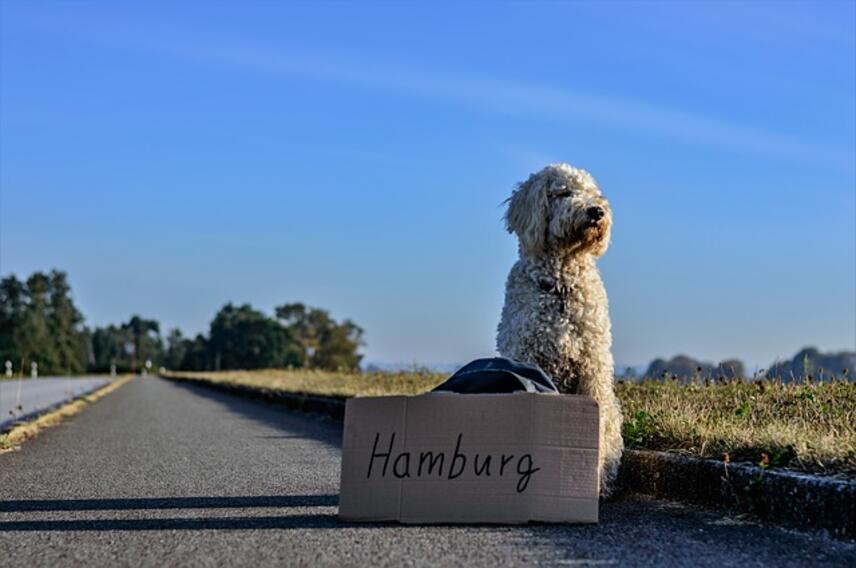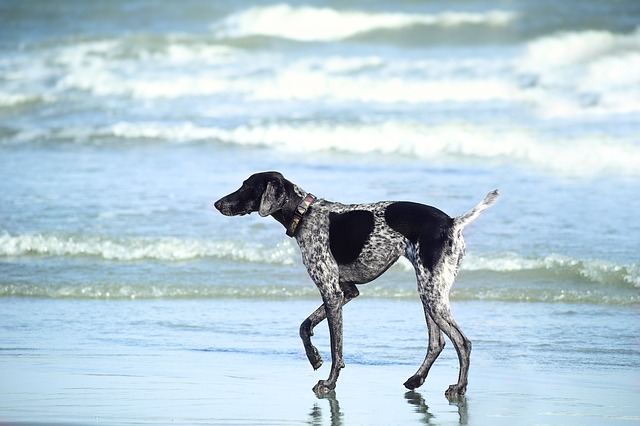The number of registered
animals is growing every day
Published: Aug 12, 2025

The sand, sea and the beautiful weather, or hiking along difficult trails and visiting historic locations? It doesn’t matter where you’re planning on going, your pet can come along too! Before taking your dog on holiday, there are some preparations to be made – discover what!
If you are going by car, you probably want to know which regulations currently apply. Polish traffic law lacks any specific provisions that deal with companion animals, but this does not mean that travelling with a dog is completely unregulated. The provisions of the Act of 20 June 1997 on traffic law must be observed, especially those that relate to transporting cargo.
According to the act, dogs must be transported in a way which:
● does not render driving more difficult,
● does not impair road visibility,
● ensures the dog is properly protected from changing its location.
The best way to ensure your dog remains comfortable and safe during your trip is by using a special harness or a kennel cage.
If you are using public transport such as buses, trains and airlines, the carrier may have special regulations that relate to transporting companion animals. Be sure to familiarise yourself with the carrier’s terms of service, and don’t forget to buy the right type of ticket.
A trip to the Baltic Sea, or a holiday in the Tatras? Poland has no shortage of dog-friendly destinations. Vacationing with a dog in Poland requires some preparation, and not only when it comes to your luggage – bear in mind that it is mandatory to have your dog vaccinated against rabies, and also to take your dog’s medical record book with a valid vaccination certification.

While travelling around Poland is quite simple, if you want to go abroad then it is essential to observe the regulations related to companion animals. For the European Union there are a few key pointers worth remembering:
1. Microchip – to cross the border of an EU member state, a dog must be microchipped (or tattooed, if the animal was marked before 3 July 2011). This is a requirement your dog must meet to receive an EU Pet Passport. Remember that after you animal is chipped, you need to register it in the www.worldpetnet.com global database. This not only means that you have a valid travel document, but should your dog ever run away, you greatly increase your chances of finding it wherever you are.
2. Rabies vaccination certificate – the vaccination date cannot be earlier than the date of chipping. If this was your dog’s first rabies vaccine, or if the interval between the vaccinations was longer than 365 days, remember that the vaccine requires 21 days to start working. Subsequent vaccinations against rabies (which should be administered every year) are valid from the date of vaccination.
3. Pet passport – issued upon the owner’s request by an authorised veterinarian, it contains information about the animal’s microchip, vaccinations etc. A pet passport is required to take your dog on holiday with you to other EU countries, as well as Andorra, Iceland, Liechtenstein, Monaco, Norway, San Marino, Switzerland and the Vatican State. A list of veterinarians authorised to issue a pet passport can be found on the website of the Polish National Veterinary Chamber.
It is worth noting that puppies younger than 12 weeks cannot travel abroad – this is because the mandatory rabies vaccine is administered to animals which are at least 12 weeks of age. Acquiring a permit for transporting a puppy younger than 12 weeks abroad is not always simple, as it requires an individual review by the Veterinary Inspectorate.
Before you begin preparations for your trip abroad, make sure to familiarise yourself with the legal regulations applicable in your destination country. Some countries, such as Finland, have additional requirements or restrictions applicable to dog breeds which they consider aggressive.
Transporting companion animals from Poland to non-EU countries is more complicated and depends on local regulations. An updated list of requirements can be found on the website of the Polish General Veterinary Inspectorate.
Travelling with a dog means that you need to bring the right equipment. What are the must-takes for a trip a dog?
The following things are useful to have with you:
● a bowl with water – make sure that your pet drinks regularly – you can buy a convenient, collapsible bowl which is perfect for a trip;
● dog food – stock up on the food and treats your dog is used to – changing its diet for the trip is certain to result in digestive problems;
● a bed or a blanket – a place to sleep, especially one that smells of home, lets your dog relax in a new place;
● a muzzle – muzzling your dog is mandatory in many places, so remember to pack it, even if your pet is generally friendly;
● a collar with a tag and a leash – your pet should always be wearing its collar with a tag or identifier containing a note that your dog is registered in the www.worldpetnet.com global database, and a QR code on the identifier can be used to look up the owner’s data without using a specialised microchip reader; in addition, your dog should always be on a leash to ensure its safety.
The date of your trip is just around the corner, but are you still unsure how to prepare your dog for the journey?

Start by making sure that its vaccines are still valid, and make sure it’s protected against parasites to ensure that your pet is always safe. Remember to protect your dog against ticks as well – they carry many diseases which are dangerous to animals, they are common not just in rural areas, and summer is the height of their activity.
Check the weather forecast before setting out, and adjust your plans to make the journey comfortable for your pet. If you are expecting high temperatures, try to avoid travelling during the day, and make sure your pet has somewhere to rest. Avoid disrupting the day-night cycle too much as well – this may stress your four-legged friend.
On the day of your trip, take your dog on a long walk full of interesting activities so that it stays fast asleep during the journey. You can also bring a few chewing toys to help it relax in the car, on the train or bus.
Travelling with a dog is not difficult if you know how to be smart about it!
To travel with a dog within the EU, ensure it is microchipped, vaccinated against rabies, and has a pet passport issued by an authorized veterinarian.
Registering your dog's microchip in WORLDPETNET enhances the chances of reuniting with your pet if it gets lost, as the database links the microchip number to your contact information.
Ensure the dog is transported in a manner that doesn't impede driving, obstruct visibility, and prevents the dog from moving freely, such as using a special harness or kennel cage.



Marking animals with a microchip is the most durable, effective and completely safe method of quick and reliable identification. Every transponder (chip) has a unique number which enables instant identification of the animal and its owner, helping them reunite faster. However, it is important to remember that a chip is just a transponder with an encoded number. It is not a tracking device and contains no data about the animal or the owner! Therefore, in order to identify a chipped dog or cat, it is necessary that a microchip be registered in a national marked animal database...
Read moreIn today's world, responsibility for animal care has become not only a priority for their owners but also a societal issue. One of the most important tools in ensuring animal safety is the chip database. It allows for the quick and efficient recovery of lost pets, which is crucial for protecting their health and well-being.
The introduction of microchipping has significantly improved the effectiveness of efforts to locate lost animals, reducing stress for both owners and their four-legged friends. Registration in the chip database is increasingly required by local regulations, further highlighting the importance of this technology in ensuring comprehensive care for animals.